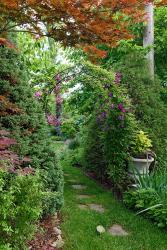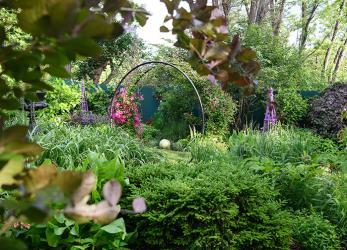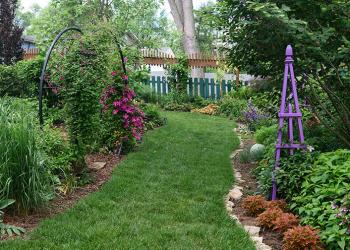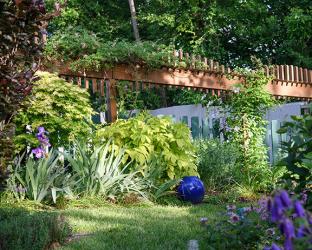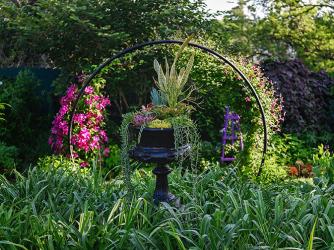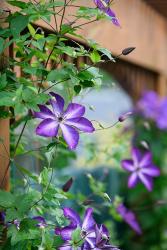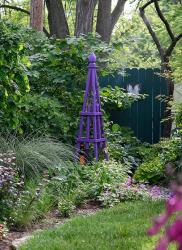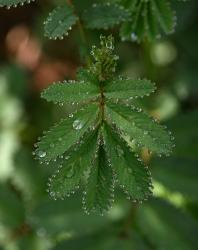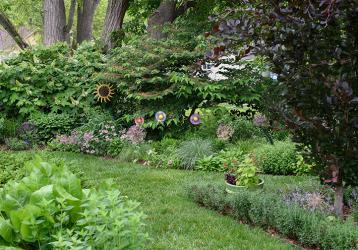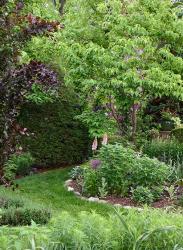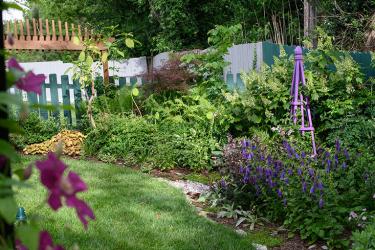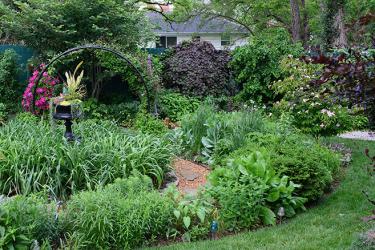It is a garden that reflects a partnership, and the beauty and harmony of working together. Although small in square footage, the landscape surrounding the Winchester home of Phil Mueller and Nathan Urben overflows with flowering plants and beautiful trees and shrubs.
To enhance the less than .15-acre space, the two have taken the garden vertical with a collection of vine-covered trellises, obelisks and arbors that bring the brilliant, saucer-like blossoms of clematis, the drooping clusters of soft purple wisteria and the tiny trumpets of red orange “Major Wheeler” honeysuckle higher than the heads of garden visitors. The trunk of a black locust tree, recently removed from the back yard, remains. The deeply furrowed bark now provides architectural interest, and the trunk serves as a trellis for the purple, sweet pea-like flowers and brilliant violet pods of hyacinth bean vines. A dwarf, purple-leaved “Ruby Falls” redbud cascades down the side of a privacy fence.
On the flip side the small garden lives large as a showcase for 80 trees, many of which, rather than being tall and vertical, remain close to the ground. One corner displays a collection of normally giant shade trees such as sycamore, white oak, American beech, American hornbeam and Japanese katsura that have been both top and root pruned to become miniature versions of their natural size.
The transformation of the space began 21 years ago when Phil purchased the property, then the repository of several “junk trees” and weeds that littered what passed for a lawn. There was, in Phil’s words, “nothing desirable” in the yard. Little by little, he began creating gardens and establishing a lawn. Then, 10 years ago, Nathan moved in and “the garden went on steroids,” Phil says laughing.
There was a reason for that. Holding a Bachelor's degree of science in horticulture from the University of Wisconsin-Madison and a Wisconsin native, Nathan moved to St. Louis in 2011 for a position as a horticulturist at the Missouri Botanical Garden.
Nathan’s area of responsibility at the Garden centered on the southeast corner of the site, encompassing the three acres surrounding the residence of the Garden’s president, the administration building and what became known as “The Stumpery.” One of the Garden’s most recent spots to stroll, “The Stumpery” is a shade-filled landscape in which logs, root wads and driftwood from dead trees, mostly recovered from the Garden’s Shaw Nature Reserve in Gray Summit, are used as natural works of art often by being turned upside down and sideways among the lush foliage.
Around the administration building, Nathan created a landscape based on the Know Maintenance Perennial Garden concept. Espoused by noted horticulturist and landscape designer Roy Diblik, such landscapes employ native plants that thrive together and grow happily and beautifully into a natural-looking vegetation-filled space, cutting down on the need for mulch and excessive watering. "It's basically a 'right plant, right place' scenario, just taken a step further," Nathan says. "It allows you to design specific plant communities, which grouped together create a garden."
After nearly 10 years at the garden, Nathan has moved on to a position as horticulturist with U City in Bloom, where he is overseeing the same concept in the city’s public spaces. He also has his own landscaping business Urben Designs.
As you might suspect, in the garden he shares with Phil, Nathan has some of the same goals. “The one thing I am adamant about is that I don’t like seeing bare ground,” Nathan says. “I don’t like mulch, per se. I like using plants to keep the weeds down.”
Where garden responsibilities are concerned, Nathan describes himself as the “curator of plants,” making most of the suggestions as to what goes into the garden and its design. In the carpentry and remodeling business, Phil has built the obelisks and arbors that enhance the landscape and in the front yard created a gravel-filled dry stream bed to harness water runoff from the street. Working mostly inside during the day, he is happy to come home, head outdoors and take on some garden maintenance chores.
The two do an evening walkabout to “see if any areas need improving and make changes and edits if a plant is not working.” Nathan says. Phil also divides garden plants and starts things from seed to sell through Facebook with profits going back into garden upkeep.
When it comes to plants, Nathan has a passion for clematis, with over 30 different varieties climbing over garden structures and even through taller plants.
Not only does he find what he calls the bright, “gaudy” flowers appealing, he loves the way the vines creep over garden structures. “I associate that with the idea of an English walled garden where flowers ramble over everything,” he says. “You can’t have that here in Missouri, but I like having climbing vines that go upward leaving a smaller footprint in the garden space and still have that floral effect.”
He also has a collection of 50 dainty, shade-loving epimediums, whose common name “bishop’s hat” or “fairy wings” perfectly describes the leaf shape and look of the plant. “It’s a small plant that doesn’t take up much space,” he notes, “but the foliage stays nice all season and the dainty, little spidery flowers in a myriad of colors can really make a show in the spring around April.”
Nathan and Phil’s passion for plants is gradually encroaching on what lawn they have left. “Some people believe that ‘less is more,’ and I believe that too,” Nathan jokes. “But I also believe that more is more. I am always looking for new things, going through seed catalogs. If it says hummingbirds or butterflies, I am always going to try it.”
The proliferation of pollinator plants in their garden has been an eye-opener for Phil. “I never knew there were so many different kinds of bees,” he says, “and I love watching the hummingbirds and bees chase one another.”
The emphasis on including plants for pollinators and being stewards of the earth is becoming the new norm for younger gardeners, Nathan notes. The trend is being seen in the increasing use of native plants in suburban and even urban landscapes. “The natives can survive drought and still look good.”
But incorporating natives into the landscape does not mean giving up on more traditional garden plants such as azaleas and boxwoods, Nathan adds. “The question is how do you balance the use of native and more traditional plants.” It is a concept Nathan and Phil continually incorporate into their garden.
Many of Nathan’s thoughts on gardening are readily available in a series of YouTube videos he recorded in his own garden during the early days of Covid, when the Missouri Botanical Garden furloughed its employees. “I was going crazy,” Nathan recalls, noting that recording the videos was a way to keep busy and impart knowledge. They are full of gardening insights and information and are easy to find simply by Googling Nathan Urben and garden.


